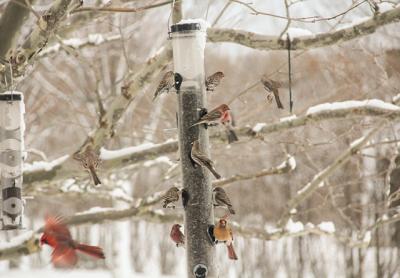Nature Notes: Feed the Birds, and the Soul

We are solidly into winter. My yard is covered with 11 inches of snow thanks to the back-to-back snowstorms of last week. Noyac Bay, 100 feet to the north, is beginning to freeze over, and it will, there being not a wisp of a breeze for several hours now.
I was at the Bridgehampton Commons last week and, while there, decided to stop in at Wild Bird Crossing. I had seen one of these squirrel-proof feeders at a friend’s house a few weeks ago, and it worked perfectly. Little birds passed in and out effortlessly.
Having not fed a bird all last winter, I decided to go into the shop. I bought a squirrel-proof cage feeder and a bag of feed to fill it with. The vertical feeding tube with feeding holes is at the center of a cage with openings in a steel meshwork slightly more than an inch wide and long. I filled the central tube with seed from the bag and hung it up outside of my bedroom window a few days before the first snowfall.
For a day and a half it just hung there without any visitors, even though I could see birds in the neighbor’s yard in the distance. Then, after a very long wait, a Carolina wren showed up and darted in, grabbed a sunflower seed, and darted out. The rest of the day the feeder sat birdless. The next day, however, not only did the Carolina wren return, but titmice and chickadees visited and, after making a quick inspection, slipped inside through the rectangular holes and began feeding. It was apparent that they were familiar with such types of feeders; birds are not dummies.
The next day, juncos and white-throated sparrows visited. Unlike the chickadees and titmice, which came and went every 15 minutes or so, they did not feed from the holes in the central tube, but sat on the bottom and fed on seeds dropped there during the other birds’ feeding activities.
Not only that, the juncos and white-throated sparrows lingered there, while the other two species came and went with the same frequency. The male junco was particularly persistent, and when other juncos and sparrows tried to get in, shooed them away. It was apparent that he was an alpha male, and he had taken over the feeder as his own.
When the junco was not around, the white-throated sparrows took their time feeding on the bottom, not minding the comings and goings of the other species, such as the wren, a female downy woodpecker, female juncos, and a song sparrow.
A single blue jay came by after two days of snow and tried to get in but was too big to fit through the holes. It would not leave without putting up a fight, however. After a few minutes of head-scratching, it managed to stick its head and neck just far enough in to reach the feeding holes in the central column and flew away with more than one, but never came back as far as I could tell.
The feeder was only three feet from my eyes as I followed all the activity from my bed, lazy bird-watcher that I’ve become. The birds didn’t mind my prying eyes; maybe, they knew that they were benevolent. I was reminded of all of those times feeding the birds from the palm of my hand at the Morton Wildlife Refuge just down the block from me in Noyac. Chickadees, titmice, and nuthatches came readily to the open hand to feed, while sparrows and juncos hung around nearby on the ground and waited for me to drop some of the stuff in my hand. They never did visit my hand, but managed to get fed anyway.
After the snow piled up, visits were less frequent. The birds were either keeping warm in the snow-covered conifers or feeding at some other table in the neighborhood. Eventually they returned, snow or not, and by Tuesday they were back in force.
The two squirrels in the neighborhood were not to be outdone by the little birds, but try as they might, they could not solve the puzzle. They even tried grabbing through the bars, but their forelegs were too short. They tried dislodging the hanging feeder, but could not. They appeared frustrated. How is it that the birds could get at the food so easily, but they could not? They seemed angry and, ultimately, departed.
I wondered how is it that when local stores and shops are going out of business left and right, Wild Bird Crossing could be there for more than 20 years, open almost every day, selling little more than bird items. There must be an awful lot more people feeding birds than I thought. And why not? It is more entertaining than television, and you can do it without leaving your house or, in my case, the bed.
Seventy years after I started feeding birds, at first just tossing breadcrumbs onto the ground behind my boyhood house in Mattituck, I was back at it. Not only was it very satisfying, it was also therapeutic. I wonder if it is therapeutic for the other bird-feeders? I bet so. I have taken a few friends to feed the birds at the Morton Wildlife Refuge, and they came away with different frames of mind. It worked for St. Francis of Assisi, perhaps it could work for those battling opioid addiction, kids being bullied in school, or lonely oldsters, a group in which I include myself.
Larry Penny can be reached via email at [email protected].
